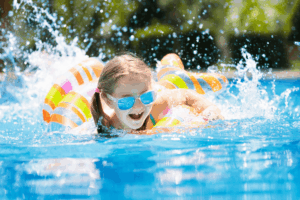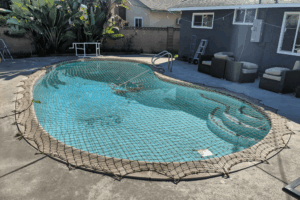
Do You Really Need Pool Safety Products If You Don’t Have Kids?
Think pool safety products are only for families with kids? Discover why fences, nets, and alarms matter for guests, pets, and liability, even if you don’t have children.
Home > How to Create a Safe and Sensory-Friendly Pool Environment for Kids

A sensory swim is an inclusive way to create safe autism swimming time for kids on the spectrum. Pool safety for kids often focuses on creating fun and enriching experiences with built-in safety. For kids who interact with the world through a non-neurotypical lens, it can be challenging to create an environment where they feel safe, engaged, and appreciated. Let’s take a look at what you can do to support swimmers with special needs by creating a quieter, less cluttered, sensory-friendly environment.
Autism can be a poorly understood, hard-to-diagnose, and life-altering condition that affects both children diagnosed with it and their loved ones. Every autistic person is a unique individual who lives with symptoms and behavioral patterns somewhere on a broad spectrum. While some autistic people may seem almost neurotypical, others may struggle to function with tasks that are considered routine in most people’s day-to-day lives.
That means before you try to apply any of the broad suggestions we make for sensory swimming, you need to learn about the autistic swimmers you’re creating a safe space for. Work to understand who they are as people and the conditions that make them most comfortable. Some may find autism swimming times most comfortable with minimal accessibility modifications, while other kids may need quiet, non-distracting surroundings to feel safe in the pool. Remember that accommodation is always about the person, not the condition.
Too many sounds overlapping each other or high volumes can easily overstimulate some autistic swimmers. Trying to follow too many voices at once, fixating on a multitude of sounds, or just being inundated with loud, booming music and vocals can become distracting or distressing quickly. Signs of distress may be hard to spot in some swimmers who seem to “shut down” when overstimulated, while others may panic and act out or exhibit concerning physical behaviors in an attempt to limit the noise or express themselves in the only way they can manage.
During sensory swimming, reduce the volume of any music that’s playing or turn it off entirely. Also, be conscious of the noise created by your pool’s accessories or other guests. Cultivating a quiet environment can reduce the stimulation to a more manageable level, making swimming with autism and all the physical sensations that come with it more manageable.

When your sensory swimming time includes motion-avoidant autistic swimmers, understand that rapid movements can be distracting or frightening if they become overwhelmed. Plan activities that let them explore the calmness of the pool. This includes more than ensuring the action doesn’t get too rough with other swimmers. Actively plan activities to engage their senses without overwhelming them.

Motion seekers love the hustle, bustle, and crash of activity–even if they happen to be easily overwhelmed by sound. To make friendly sensory swimming activities for these kids, find controlled ways to let them harness the full range of motion, mobility, and activity the pool offers. Swimming has been shown to engage both sides of the brain, training the mind to map across hemispheres to encourage better coordination, focus, and problem-solving.
Physical contact is frequently a triggering experience for autistic children and adults. Work to understand their individual preferences and keep to their boundaries when interacting. This may allow for guidance by hand, or even that minimal contact may be too much. Be sure to talk to the child about your intent and set expectations when starting these interactions and throughout. The focus is on keeping pool activities kid-safe while providing a welcoming, sensory-friendly swimming environment, so balance those two needs when deciding on your course of action.
Remember to communicate with guests, parents, and other children about any behavioral expectations you have for them or that they should have for the swimming event. Sensory-friendly swimming takes everybody’s cooperation, but the results can be engaging and validating for the swimmers who need these small and reasonable accommodations to enjoy their swim time.
Safety barriers help control the action in and around the pool area and keep swimmers safer from unsupervised access. Swimming pool safety nets and pool safety covers block access to the water’s surface. Removable mesh pool fencing helps moderate traffic around the pool area, filters excess movement outside the pool for more sensory-sensitive swimmers, and provides a partial wind block to ease its effects on water.
Your local independent installer is your community’s best resource for kids pool safety. They can help design a pool safety barrier plan that maintains your pool’s beauty while keeping your loved ones safe. Make sure your pool is ready for sensory-friendly swimming. Get your free estimate from an All-Safe Pool pro today.

Think pool safety products are only for families with kids? Discover why fences, nets, and alarms matter for guests, pets, and liability, even if you don’t have children.

When most people think about pool safety, they picture a

Not every city has the same pool safety requirements. Learn how to plan a code-compliant barrier system using fences, nets, or covers while meeting local standards.
Enter your zip code to locate an independent installer in your area
Enter your zip code to locate an independent installer in your area
Enter in your zip code to let us know where your pool is located.
Due to the many variations in monitors, phones, and browsers, color samples and product examples may appear different on different screens. Computers and mobile devices are not all calibrated equally and color reproduction on the Internet is not precise. The same is true for printed items such as brochures and other sales literature.
In addition, the colors of our products photograph differently under different lighting conditions. For example, photos taken in full sunlight will vary from photos taken on a cloudy or overcast day. Similarly, shadows from nearby objects can affect the color and transparency of our products. If a precise color or specific shade is important, please inspect the actual color of your product prior to installation.
Many of our products’ materials are not available through typical stores and vendors and therefore must be custom manufactured specifically for our use. In order to control costs and provide you with the best value possible, our raw materials are produced in large batches and can often take several months to receive. The colors of our materials can, and often do, vary slightly from batch to batch. Although we make every effort to minimize color variations, we cannot be responsible for these differences when they occur. If a precise color or specific shade is important, please inspect the actual color of your product prior to installation.
For example, we use the name “putty” to describe some of our products. Your idea of the color “putty” may be different than someone else’s idea of “putty”. In addition, products may have the same color name but may not be the exact same color. For example, we have different shades of “black”. Please do not order using color names as your only guide. If a precise color or specific shade is important, please inspect the actual color of your product prior to installation.
If it is important that your product be an exact color or shade, it is highly recommended that you inspect the actual product prior to its installation and address any concerns with your local independent installer. Most independent installers do not offer refunds or accept returns due to color variations.